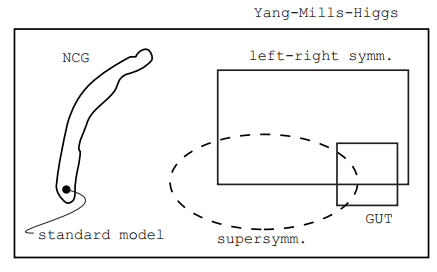Successive slidings of SUSY looking for a better place...
... in the sun of phenomenological reality
... in a spectral noncommutative frame
Already shortly after the advent of supersymmetry it was realized [98] that if it is a real symmetry of nature, then the superpartners should be of equal mass. This, however, is very much not the case. If it were, we should have seen all the sfermions and gauginos that feature in the Minimal supersymmetric Standard Model (MSSM, e.g. [39]) in particle accelerators by now. In the context of the MSSM we need [55] a supersymmetry breaking Higgs potential to get electroweak symmetry breaking and give mass to the SM particles. Somehow there should be a mechanism at play that breaks supersymmetry. Over the years many mechanisms have been suggested that break supersymmetry and explain why the masses of superpartners should be different at low scales. Ideally this should be mediated by a spontaneous symmetry breaking mechanism, such as D-term [80] or F-term [45] supersymmetry breaking. But phenomenologically such schemes are disfavoured, for they require that ‘in each family at least one slepton/squark is lighter than the corresponding fermion’ [39, §9.1].Alternatively, supersymmetry can be broken explicitly by means of a supersymmetry breaking Lagrangian. In order for the solution to the hierarchy problem that supersymmetry provides to remain useful, the terms in this supersymmetry breaking Lagrangian should be soft [51]. This means that such terms have couplings of positive mass dimension, not yielding the quadratically divergent loop corrections that would spoil the solution to the hierarchy problem (the enormous sensitivity of the Higgs boson mass to perturbative corrections) that supersymmetry provides.
Thesis defended on 5 September 2014 (p 121)
... in a spectral noncommutative frame
⇓
For long, the [top] figure that was presented in [87] was believed to be correctly describing the (empty) intersection between noncommutative geometry and supersymmetry. In our view this should be slightly modified, to yield [the bottom] figure... The question that is still open is how big that intersection actually is, and exactly how ‘far’ the MSSM is away from it, i.e. if there are models resembling the MSSM that do exhibit a supersymmetric action. This calls for a constructive approach generating a list of (experimentally viable) supersymmetric spectral triples.




Comments
Post a Comment
Cher-ère lecteur-trice, le blogueur espère que ce billet vous a sinon interessé-e du moins interpellé-e donc, si le coeur vous en dit, osez partager avec les autres internautes comme moi vos commentaires éclairés !
Dear reader, the blogger hopes you have been interested by his post or have noticed something (ir)relevant, then if you are in the mood, do not hesitate to share with other internauts like me your enlightened opinion !